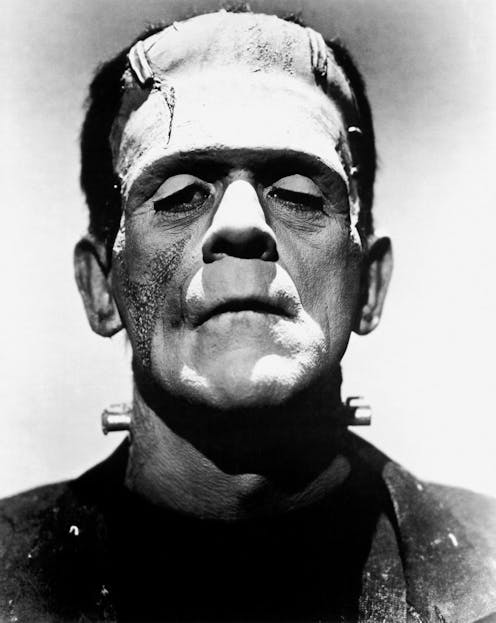Frankenstein: how Mary Shelley's sci-fi classic offers lessons for us today about the dangers of playing God
- Written by Jamie Q Roberts, Lecturer in Politics and International Relations, University of Sydney

In our Guide to the Classics series, experts explain key works of literature.
Frankenstein, or, The Modern Prometheus, is an 1818 novel by Mary Wollstonecraft Shelley. Set in the late 18th century, it follows scientist Victor Frankenstein’s creation of life and the terrible events that are precipitated by his abandonment of his creation. It is a Gothic novel in that it combines supernatural elements with horror, death and an exploration of the darker aspects of the psyche.
It also provides a complex critique of Christianity. But most significantly, as one of the first works of science-fiction, it explores the dangers of humans pursuing new technologies and becoming God-like.
The celebrity story
Shelley’s Frankenstein is at the heart of what might be the greatest celebrity story of all time. Shelley was born in 1797. Her mother, Mary Wollstonecraft, author of the landmark A Vindication of the Rights of Women (1792), was, according to that book’s introduction, “the first major feminist”.
Shelley’s father was William Godwin, political philosopher and founder of “philosophical anarchism” – he was anti-government in the moment that the great democracies of France and the United States were being born. When she was 16, Shelley eloped with radical poet Percy Shelley, whose Ozymandias (1818) is still regularly quoted (“Look on my Works, ye Mighty, and despair!”).
Their relationship seems to epitomise the Romantic era itself. It was crossed with outside love interests, illegitimate children, suicides, debt, wondering and wandering. And it ultimately came to an early end in 1822 when Percy Shelley drowned, his small boat lost in a storm off the Italian coast. The Shelleys also had a close association with the poet Lord Byron, and it is this association that brings us to Frankenstein.
In 1816 the Shelleys visited Switzerland, staying on the shores of Lake Geneva, where they were Byron’s neighbours. As Mary Shelley tells it, they had all been reading ghost stories, including Coleridge’s Christabel (Coleridge had visited her father at the family house when Shelley was young), when Byron suggested that they each write a ghost story. Thus 18-year-old Shelley began to write Frankenstein.
The myth of the monster
The popular imagination has taken Frankenstein and run with it. The monster “Frankenstein”, originally “Frankenstein’s monster”, is as integral to Western culture as the characters and tropes from Lewis Carroll’s Alice’s Adventures in Wonderland.
But while reasonable continuity remains between Carroll’s Alice and its subsequent reimaginings, much has been changed and lost in the translation from Shelley’s novel into the many versions that are rooted in the popular imagination.
There have been many varied adaptations, from Edward Scissorhands to The Rocky Horror Picture Show (see here for a top 20 list of Frankenstein films). But despite the variety, it’s hard not to think of the “monster” as a zombie-like implacable menace, as we see in the trailer to the 1931 movie, or a lumbering fool, as seen in the Herman Munster incarnation. Further, when we add the prefix “franken” it’s usually with disdain; consider “frankenfoods”, which refers to genetically modified foods, or “frankenhouses”, which describes contemporary architectural monstrosities or bad renovations.
However, in Shelley’s novel, Frankenstein’s creation is far from being two-dimensional or contemptible. To use the motto of the Tyrell corporation, which, in the 1982 movie Bladerunner, creates synthetic life, the creature strikes us as being “more human than human”. Indeed, despite their dissimilarities, the replicant Roy Batty in Bladerunner reproduces Frankenstein’s creature’s intense humanity.
Some key elements in the plot
The story of Victor Frankenstein is nested within the story of scientist-explorer Robert Walton. For both men, the quest for knowledge is mingled with fanatical ambition. The novel begins towards the end of the story, with Walton, who is trying to sail to the North Pole, rescuing Frankenstein from sea ice. Frankenstein is being led northwards by his creation towards a final confrontation.
The central moment in the novel is when Frankenstein brings his creation to life, only to be immediately repulsed by it:
I had worked hard for nearly two years, for the sole purpose of infusing life into an inanimate body. For this I had deprived myself of rest and health. I had desired it with an ardour that far exceeded moderation but now that I had finished, the beauty of the dream vanished, and breathless horror and disgust filled my heart.
Victor Frankenstein, like others in the novel, is appalled by the appearance of his creation. He flees the creature and it vanishes. After a hiatus of two years, the creature begins to murder people close to Frankenstein. And when Frankenstein reneges on his promise to create a female partner for his creature, it murders his closest friend and then, on Frankenstein’s wedding night, his wife.
More human than human
The real interest of the novel lies not in the murders or the pursuit, but in the creature’s accounts of what drove him to murder. After the creature murders Frankenstein’s little brother, William, Frankenstein seeks solace in the Alps – in sublime nature. There, the creature comes upon Frankenstein and eloquently and poignantly relates his story.



